Factors affecting children’s mental health and wellbeing: findings
Results from the 2015- 2017 Realigning Children's Services Wellbeing Surveys into factors effecting mental health and wellbeing amongst children and young people in Scotland.
This document is part of a collection
3 Secondary school findings
This chapter presents the findings of the secondary school survey analysis. It contains three sections, which cover the research questions outlined in Section 1.3.
Section 3.1 addresses research question 1. It presents the prevalence rates for each mental health outcome (emotional problems, conduct problems, positive mental wellbeing), including a breakdown by school year, gender and area deprivation.
Section 3.2 addresses research question 2. It presents the prevalence rates for secondary school pupils with each individual risk factor (and with multiple risk factors in a domain).
Section 3.3 addresses research questions 3 and 4. For each mental health outcome in turn, it presents associations with risk and protective factors when these are considered: (a) individually; (b) as clusters within a domain; (c) after accounting for the influence of other factors.[20]
3.1 Prevalence of mental health and wellbeing outcomes
3.1.1 Prevalence of emotional problems
Overall, 17% of S1-S4 pupils were classed as having ‘very high’ emotional problems on the Strengths and Difficulties Questionnaire (SDQ). Figure 1 shows the percentage of pupils with emotional problems by school year, gender and deprivation.
Rates were higher for girls and this gap widened with age: by S4, 1 in 3 girls had very high emotional problems compared to 1 in 10 boys. There was a smaller but significant gap for deprivation: 19% of pupils living in the most deprived areas had very high emotional problems, compared to 15% of those in the least deprived areas.
Figure 1: Prevalence of emotional problems
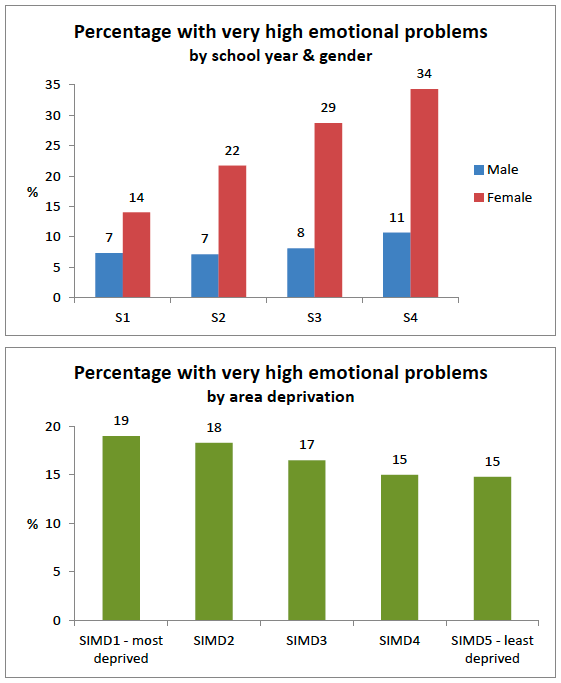
3.1.2 Prevalence of conduct problems
Overall, 5% of S1-S4 pupils were classed as having ‘very high’ conduct problems on the SDQ. Figure 2 shows the percentage of pupils with conduct problems by school year, gender and deprivation.
Rates were higher for boys. For both genders, conduct problems were lowest in S1 and peaked in S3. Conduct problems were more common amongst children living in more deprived areas: 7% in the most deprived areas compared to 4% in the least deprived areas.
Figure 2: Prevalence of conduct problems
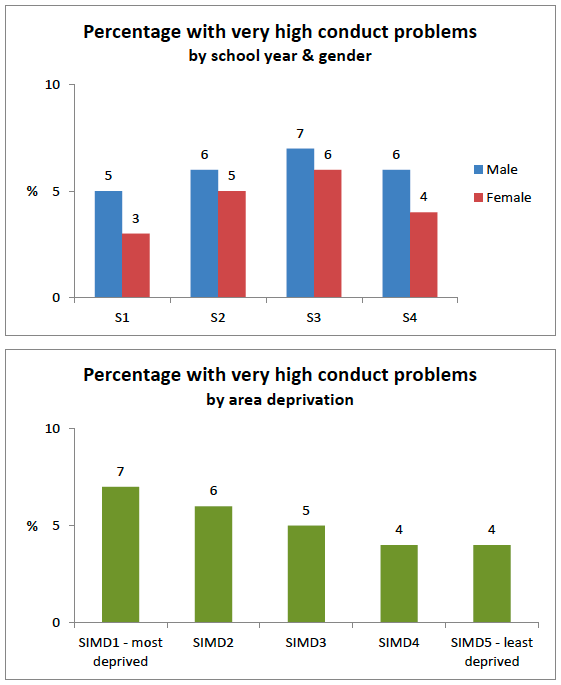
3.1.3 Prevalence of high positive mental wellbeing
Overall, 14% of S1-S4 pupils were classed as having ‘high positive mental wellbeing’ using a cut-off score of 1 standard deviation above the mean Warwick-Edinburgh Mental Wellbeing Scale (WEMWBS) score from the 2015 SALSUS results. Figure 3 shows the percentage of pupils with high positive mental wellbeing by school year, gender and deprivation.
Figure 3: Prevalence of high positive mental wellbeing

The prevalence of high positive mental wellbeing decreased with age for both boys and girls, but this decline was sharper for girls. In S1, boys and girls were equally likely to have high mental wellbeing (roughly 20% of each). By S4, 14% of boys and only 6% of girls were classed as having high positive mental wellbeing.
Although the difference in positive mental wellbeing between the most and least deprived areas was statistically significant, this gap was modest. Only 2 percentage points separated children from the least deprived areas (16%) and children from more deprived areas (14%).
Summary: Girls (especially older girls) are more likely to have emotional problems and less likely to have high positive mental wellbeing. Boys are more likely to have conduct problems. Children from more deprived areas are more likely to have emotional and conduct problems and slightly less likely to have high positive mental wellbeing.
3.2 Prevalence of risk and protective factors
Table 1 presents the prevalence of each potential risk factor. The most common risk factors were feeling that there was nothing to do for young people locally (46%) and experiencing bullying or prejudice (40%). The least common risk factors were child-rated poor general health (2%) and having few or no friends (5%).
Table 1: Prevalence of individual risk factors in each domain[21]
| Domain | Risk factor | % of children |
|---|---|---|
| Family | Child would not speak to a family member if worried | 26% |
| Family members shout a lot | 23% | |
| Family rarely or never shares meals | 11% | |
| Child does not enjoy spending time with family | 11% | |
| School | Pupils do not respect each other | 39% |
| Child feels strained by schoolwork | 33% | |
| Child does not like school | 31% | |
| Child feels that teachers do not care about them | 29% | |
| Peer | Child experiences bullying | 40% |
| Child experiences prejudice (from young people or adults) | 40% | |
| Other pupils do not accept child | 16% | |
| Child has few or no friends | 5% | |
| Area | Nothing for young people to do in the area | 46% |
| Child could not ask neighbours for help | 33% | |
| People do not say ‘hello’ or stop to talk in the street | 30% | |
| Child does not feel safe in area | 23% | |
| Health | Child is rarely or never physically active | 7% |
| Child rates own health as ‘bad’ or ‘very bad’ | 2% |
Generally, risk factors tended to be more prevalent amongst older pupils, girls and those from more deprived areas. This is why it is important to control for these characteristics when analysing associations, to compare similar pupils with and without each risk factor.
The analysis also examined the total number of risk factors that pupils had in each domain[22]. Figure 4 shows that most children had few or no risk factors in each domain. However a significant minority had multiple risk factors: the percentage of pupils with three or more risk factors ranged from 4% in the Family domain to 10% in the School domain.
Figure 4: Prevalence of multiple risk factors in each domain
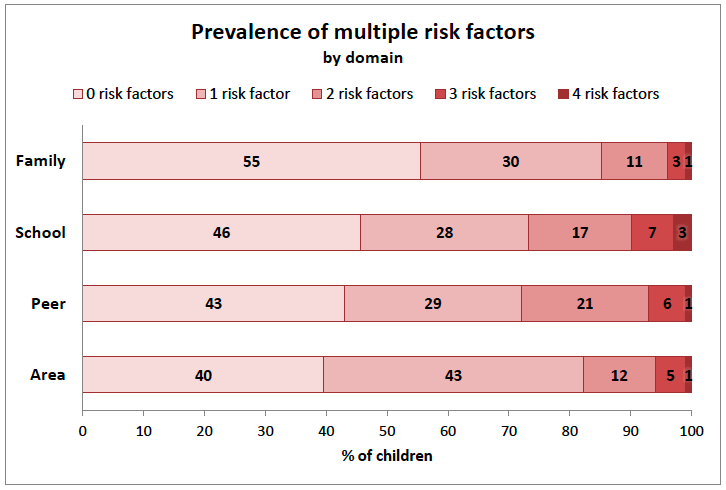
Older children and those from more deprived areas tended to have a higher number of risk factors in all four domains. Girls also tended to have more risk factors than boys in the School and Peer domains. This underlines the importance of controlling for child characteristics like age, gender and deprivation when trying to identify which risk factors most strongly contribute to mental health and wellbeing.
These four domains are distinct but associated. It is possible to have high risk in one domain and low risk in others. However pupils with high risk in one domain were more likely to have high risk in others. This is why it is important to not only examine each factor or domain individually, but also examine whether its association remains significant after accounting for the combined influence of other domains simultaneously (see research question 4, outlined in Section 1.3).
3.2.1 Note on protective factors
As outlined in Section 2.3, this report refers to negative experiences as possible ‘risk factors’ for emotional and conduct problems, but reverses these comparisons to examine the opposite (i.e. positive) experiences as possible ‘protective factors’ for positive mental wellbeing. For example, whilst 11% of pupils rarely or never shared family meals (referred to as a possible ‘risk factor’), this means that 89% of pupils shared family meals at least once a week (referred to as a possible ‘protective factor). Similarly, although 5% of pupils had three or four negative experiences (risk factors) in the family domain, 55% had all positive experiences in this domain (i.e. zero risk factors, or four protective factors).
Summary: Most secondary school pupils have generally positive experiences with their family, school, peers, area and health. However, a significant minority have clusters of multiple risk factors.
3.3 Mental health associations of risk and protective factors
To address research questions 3 and 4 (as outlined in Section 1.3) the analysis examined how strongly each outcome in turn (emotional problems, conduct problems and positive mental wellbeing) was associated with risk or protective factors when these were considered: (a) individually; (b) as clusters within a domain; (c) after accounting for the influence of other factors.
3.3.1 Emotional problems
Individual risk factors for emotional problems
The analysis first explored individual risk factors within each domain (Family, School, Peer, Area, Health) that were associated with emotional problems. Pupils with a particular risk factor were more likely to have emotional problems than similar pupils without that risk factor.
Figure 5 shows the strength of associations between each individual risk factor and emotional problems. Generally, emotional problems were associated with poor family and peer relationships, and negative perceptions of school and neighbourhood environments.
Figure 5: Individual risk factors for emotional problems in each domain[23]
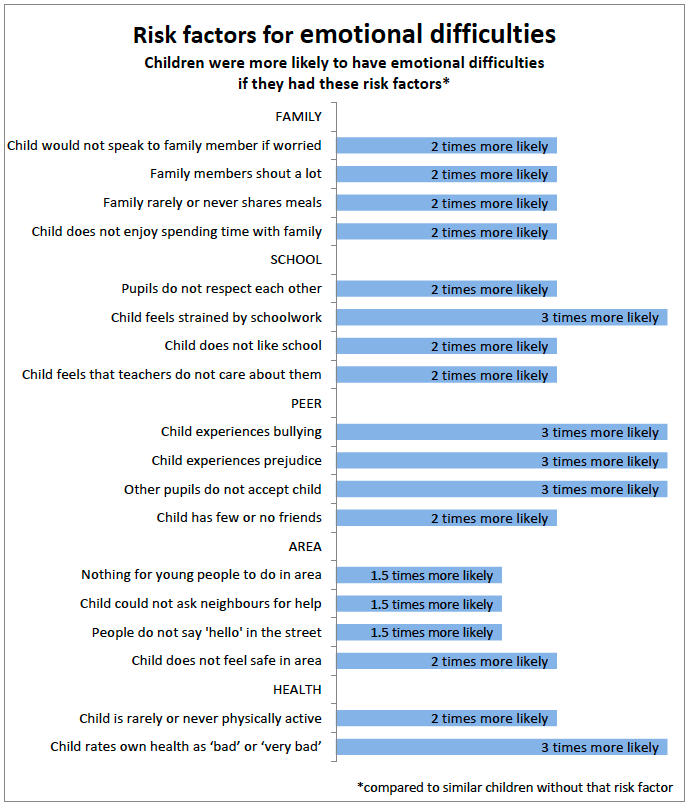
For example, pupils who experienced bullying were 3 times more likely to have emotional difficulties than similar pupils who did not experience bullying. Here, “similar” pupils means pupils with the same age, gender, ethnicity, household composition, area deprivation and free school meal eligibility (see Section 2.4.1 on control variables).
Clusters of risk factors for emotional problems
Although each of these risk factors were associated with emotional problems individually, outcomes were poorest for pupils with multiple risk factors in a domain. Figure 6 shows how the likelihood of emotional problems increases for pupils with 1, 2, 3 or 4 risk factors in a domain, compared to similar pupils with no risk factors in that domain.
Figure 6: Multiple risk factors for emotional problems[24]
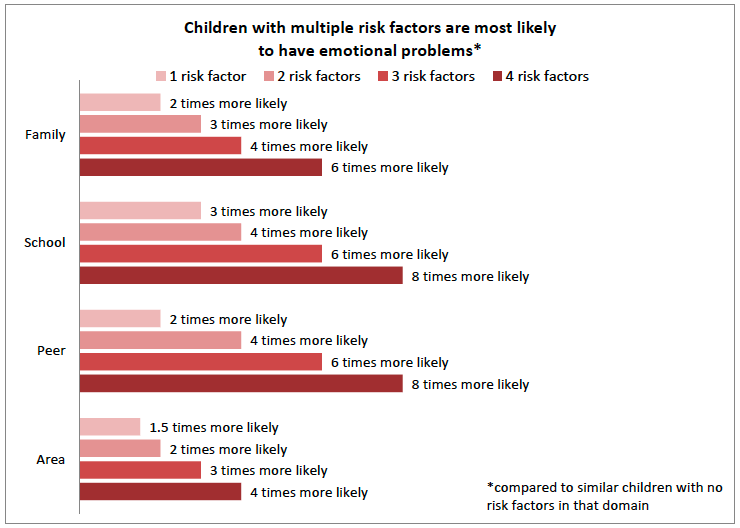

For example, a pupil with only one of the family risk factors identified here (e.g. rarely sharing family meals) is 2 times more likely to have emotional problems, but a pupil with all four family risk factors (who rarely shares family meals, has high family conflict, does not enjoy family time and has no trusted family member to speak to) is 6 times more likely to have emotional problems.
The chances of emotional problems were particularly high for pupils with several risk factors in the Peer domain (who experienced bullying, prejudice and social exclusion and isolation) or the School domain (who felt strained by schoolwork, disliked school and did not feel that pupils or teachers were respectful or caring).
Risk factors for emotional problems accounting for other influences
The final analysis stage examined whether these associations remained significant after accounting for the influence of all domains together. This is important to explore, because pupils with high risk in one domain were also more likely to have high risk in other domains.
After accounting for this by examining factors simultaneously, each of the four domains were still significantly associated with emotional problems. The chances of emotional problems were most strongly associated with the level of risk in the Peer domain, followed by the School and Family domains. The association between the Area domain and emotional problems was still significant but it was the weakest. Table 2 summarises which risk factors were significant or non-significant after accounting for the influence of each other.
Table 2: Significance of different risk factors for emotional problems[25]
| Risk factor | Still significant?* | |
|---|---|---|
| Gender (female) | √ | |
| More deprived area | X | |
| Family risk | √ | |
| School risk | √ | |
| Peer risk | √ | |
| Area risk | √ | |
*after accounting for other factors here
Girls were still more likely to have emotional problems than boys with similar demographics and similar levels of risk in each of these domains. This means that the observed gender gap in prevalence rates of emotional problems cannot be explained by the fact that girls tend to have more risk factors in these domains (especially School and Peer). For example, although girls are more likely to feel strained at school or excluded from their peers, these factors cannot account for higher rates of emotional problems in girls.
In contrast, area deprivation was no longer significantly associated with emotional problems, after accounting for levels of risk in these four domains. This means that the deprivation gap in prevalence rates of emotional problems can be explained by pupils in more deprived areas tending to have more risk factors in each of these domains. To illustrate this, Table 3 presents the percentage of pupils from the most and least deprived areas with at least three risk factors in each domain. It shows that pupils from more deprived areas are more likely to be exposed to multiple risk factors in each of these domains (which all contribute to emotional problems).
Table 3: Exposure to multiple risk factors in the most vs. least deprived areas
| Domain | % of pupils with at least 3 risk factors | ||
|---|---|---|---|
| SIMD1 – most deprived | SIMD5 – least deprived | ||
| Family | 4.7 | 2.1 | |
| School | 9.8 | 8.2 | |
| Peer | 7.2 | 5.6 | |
| Area | 7.6 | 2.8 | |
This means that the deprivation gap in rates of emotional problems can be explained by pupils from more deprived areas tending to have poorer experiences in family and peer relationships, and more negative perceptions of their school and neighbourhood environments. Therefore area deprivation is a marker for exposure to risk factors for poor mental health, rather than a driver of poor mental health itself.
3.3.2 Conduct problems
Individual risk factors for conduct problems
Generally, conduct problems were associated with poor family and peer relationships, and negative perceptions of school and neighbourhood environments. Figure 7 shows how strongly each individual risk factor was associated with conduct problems. The strongest risk factors included not enjoying family time or school, and experiencing bullying or conflict at home.
Figure 7: Individual risk factors for conduct problems in each domain[26]
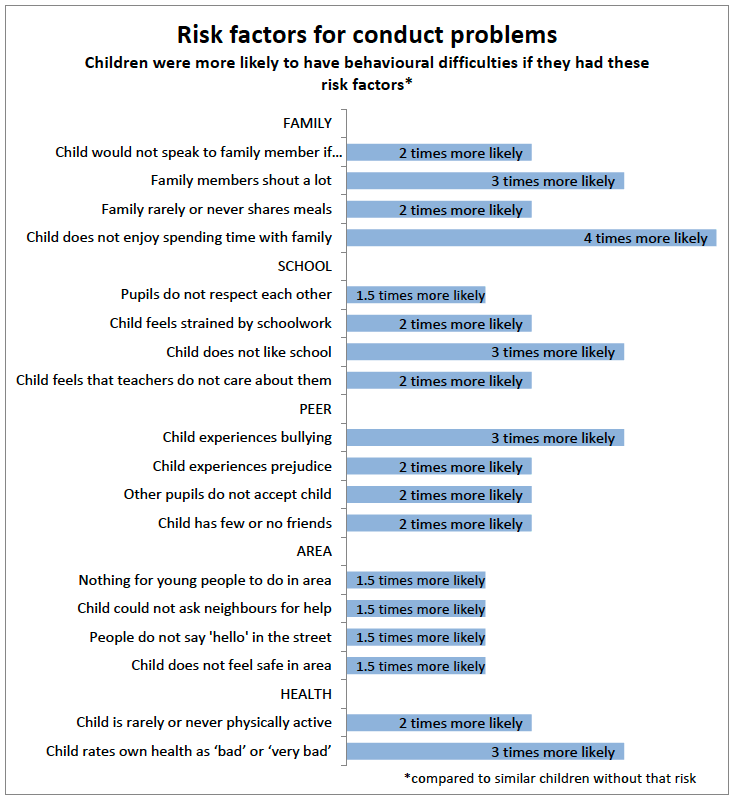
Clusters of risk factors for conduct problems
As with emotional difficulties, the chances of having conduct problems were highest for those pupils with clusters of multiple risk factors in a domain. Figure 8 shows that the likelihood of having conduct problems was particularly high for pupils with several risk factors in the Family domain, closely followed by Peer. As with emotional difficulties, Area showed the weakest association with conduct problems of the four domains.
Figure 8: Multiple risk factors for conduct problems[27]
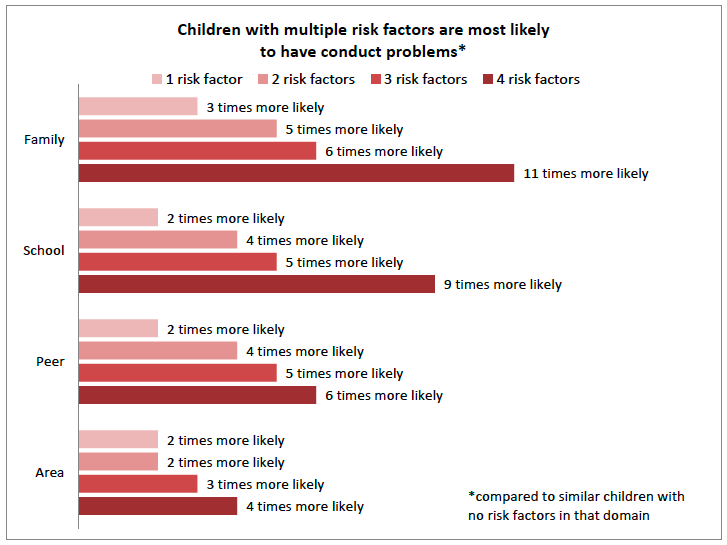
Risk factors for conduct problems accounting for other influences
When examining domains simultaneously, the chances of conduct problems were most strongly associated with the level of risk in the Family domain, followed by the School and Peer domains.
The association between the Area domain and conduct problems was no longer significant after accounting for the other domains. This indicates that although pupils with poorer perceptions of their area are slightly more likely to have behavioural problems, this association can be explained by the fact that these pupils also tend to have poorer experiences in other domains (Family, School and Peer).
Table 4 summarises which risk factors still significantly predicted conduct problems after accounting for the influence of each other.
Table 4: Significance of different risk factors for conduct problems[28]
| Risk factor | Still significant?* | |
|---|---|---|
| Gender (male) | √ | |
| More deprived area | √ | |
| Family risk | √ | |
| School risk | √ | |
| Peer risk | √ | |
| Area risk | X | |
*after accounting for other factors here
Together these risk factors did not explain the deprivation gap in conduct problems, as area deprivation remained a significant predictor. Pupils in more deprived areas were still more likely to have conduct problems after accounting for levels of risk in these four domains. Similarly, boys were still more likely than girls to have conduct problems, allowing for these factors.
3.3.3 Positive mental wellbeing
Individual protective factors for positive mental wellbeing
For factors associated with positive mental wellbeing, rather than negative experiences as potential ‘risk factors’, the analysis examined the opposite (positive) experiences as potential ‘protective factors’.
Positive mental wellbeing was associated with good quality relationships with family and peers, positive experiences in school and positive perceptions of the local area. Figure 9 summarises how strongly each protective factor is associated with positive mental wellbeing. The strongest protective factors included feeling accepted by other pupils, liking school and having a trusted family member to speak to if worried.
Figure 9: Individual protective factors for positive mental wellbeing[29]
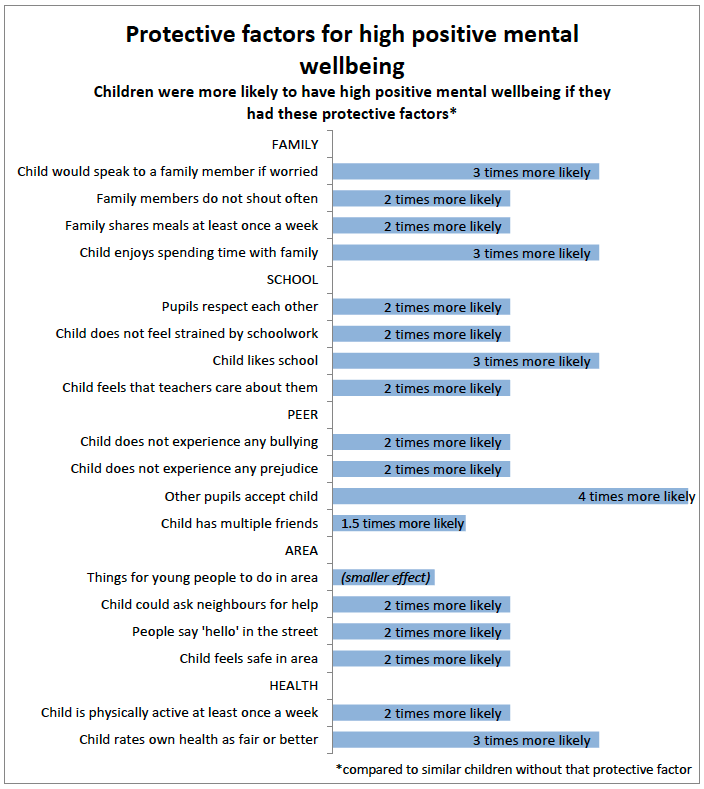
Clusters of protective factors for positive mental wellbeing
Pupils with multiple protective factors in a domain were most likely to have high positive mental wellbeing. Figure 10 shows how the chances of having high positive mental wellbeing increased with each additional protective factor.
Figure 10: Multiple protective factors for positive mental wellbeing[30]

When examining domains simultaneously, the strongest predictors of having high mental wellbeing were the Family and School domains, followed by the Peer and Area domains (which had smaller but significant associations).
Table 5 summarises which protective factors were still significantly associated with positive mental wellbeing after accounting for the combined influence of other factors.
Table 5: Significance of different protective factors for positive mental wellbeing[31]
| Protective factor | Still significant?* | |
|---|---|---|
| Gender (male) | √ | |
| Less deprived area | X | |
| Family | √ | |
| School | √ | |
| Peer | √ | |
| Area | √ | |
*after accounting for other factors here
After accounting for these factors, the previously observed small gap for deprivation was no longer significant. However, gender was still significantly associated with positive mental wellbeing even allowing for these other factors. Therefore boys were still more likely to have positive mental wellbeing than girls with similar characteristics and similar numbers of these protective factors.
Chapter summary: There are gender and deprivation inequalities in secondary school pupils’ mental health and wellbeing. Pupils with multiple risk factors are most vulnerable to poor mental health. Positive interactions with other young people and adults are particularly important to good mental health and wellbeing.
Contact
Email: franca.macleod@gov.scot
There is a problem
Thanks for your feedback